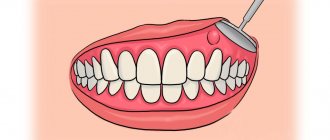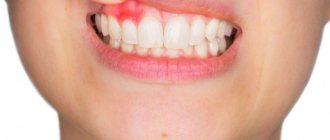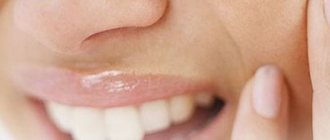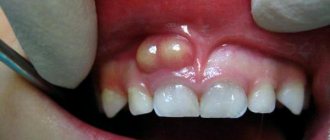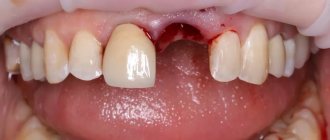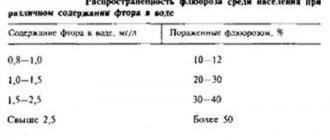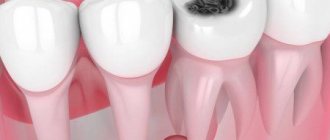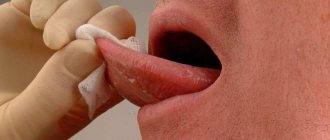A gingival fistula or fistula on the gum is a kind of channel connecting the source of inflammation with the surface of the gingival tissue.
The main task of fistula tracts is to remove purulent and other pathological masses from abscesses in the periodontium or in the thickness of the jaw. In other words, the appearance of gum fistulas is caused by the need to remove exudate from the body that has accumulated in areas of inflammation.
Most often, a fistula on the gum is a thin canal lined with epithelium. Normally, after the elimination of the main inflammatory process in the thickness of the tissue, the fistula tracts heal on their own, without medical intervention. However, in cases where the problem is not eliminated in time, and a cavity affected by infection remains deep in the gum tissue, the fistulas do not grow together, but are transformed into foci of purulent inflammation, which can cause the development of serious malfunctions in the functioning of the dental system and the body as a whole.
What does a fistula on a child’s gum look like?
It's just a purulent tubercle with a hole. Symptoms of the formation of a fistula on the gums of a child are fever, acute pain, bad breath, difficulty breathing. These signs should be a reason for parents to urgently consult a dentist.
Where does this misfortune come from? The age of the baby sometimes helps to understand the cause of the disease.
- ✔
At two years old, a fistula on the gums of a child most likely indicates congenital pathologies of the dentition.
✔
Up to three years of age, a fistula on the gum in a child can be caused by osteomyelitis.
✔
At the age of 4, a child’s fistula on the gum usually occurs due to inflammation of the maxillary sinuses.
✔
In a 5-6 year old child, a fistula on the gum may appear after an injury and indicate the presence of an inflammatory process in the body.
Treatment of gingival fistula
The treatment of fistulas on the gums is based on the principle of eliminating all factors that contribute to the formation of fistulas. Along with treatment of the underlying disease, the patient is prescribed a course of rehabilitation measures. In particular, the affected gum is treated with ultrasound or laser, cauterized with diathermic current, and antibacterial solutions, special gels, rinses and toothpastes are used to eliminate the inflammatory process. If necessary, the patient is prescribed antihistamines (suprastin, tavegil and others).
If complications develop, for example, if the pathological process spreads to the periosteal tissue, surgical removal of the fistula is performed. After completion of the operation, the patient is also prescribed a course of rehabilitation measures.
Fistula in a child as a consequence of periodontitis
Periodontitis is an inflammatory disease of the tissues surrounding the root of the tooth.
As a rule, in children it is asymptomatic and with minimal pain. A common form of periodontitis in primary teeth is chronic granulating, and a fistula on the gum is a common addition to this disease. This is due to the anatomical features of the bone structure in children and the physiological changes that constantly occur in it. For example, on the gum of a baby tooth, a fistula in a child often appears due to improper eruption. In the granulating form of periodontitis, an odontogenic fistula can form on the gums, skin, and submandibular region. The disease is preceded by excessive growth of granulations (tissue with a granular surface that develops during the healing of wounds and foci of inflammation). During the course of the disease, a shallow carious cavity forms, the mucous membrane around the tooth turns red, it becomes mobile, and the inflammatory process provokes the appearance of a fistula in the child. If left untreated, the infection spreads to other organs.
Symptoms accompanying the appearance of a fistula:
- pain, which, however, may not be present;
- mobility of the tooth next to which there is a hole;
- swelling and redness of the affected gum;
- purulent discharge from the hole.
It is difficult and excruciating for children to endure pain, so if these signs are detected, you should seek medical help immediately. Doctors at Family Dentistry know how to work with young patients, and many years of experience guarantee a correct and painless solution to the problem.
At the clinic, the doctor will first identify the cause of the disease. They may be:
- Insufficient oral care. The consequences are caries, and in the absence of proper treatment - pulpitis on one or more teeth. Later, the inflammation descends into the ligamentous tissue of the tooth, where a cavity with pus is formed;
- inflammation of the gums;
Purulent fistula on the gum of a child
Odontogenic osteomyelitis, like periodontitis, is characterized by the presence of purulent inflammation and the formation of fistulas on the gums in children. The source of infection is caries: in 80–87% of cases this is true for primary molars and the first permanent chewing tooth on the upper or lower jaws. Among the prerequisites for the disease are age-related imperfections of the immune system, which, in turn, is associated with the immaturity of the nervous, endocrine and lymphatic systems. Physical fatigue, hypothermia and previous infectious diseases contribute to the development of osteomyelitis. Timely treatment of a purulent fistula on the gums of a child will help avoid abscess, inflammation of the molar and infection of internal organs.
Prevention of gingival fistulas
The main measures aimed at preventing the formation of gingival fistulas are:
- compliance with all requirements of individual oral hygiene;
- Regular visits to the dentist and professional teeth cleaning;
- proper nutrition;
- healthy lifestyle.
It is important to understand that the effectiveness of the treatment of fistulas on the gums directly depends on the timely detection of the pathological process and the establishment of the causes of its occurrence. It is for this reason that the detection of any symptoms indicating the presence of a fistula in the gum tissue is the basis for a visit to the dental clinic and receiving the necessary medical care.
Cause of primary fistula
Sinusitis is one of the causes of primary fistula. After removing a diseased tooth in the upper jaw, there is a risk of the formation of a fistula tract (ostium) between the maxillary sinus and the oral cavity through the tooth socket. Bacteria penetrate through it from the oral cavity, which provokes inflammation of the sinuses. Usually the hole lasts from 7 to 10 days, then it epithelializes and takes the form of a fistula tract. This is the so-called primary fistula. A secondary fistula forms after an unsuccessful operation.
Fistula in the soft periodontal tissues after tooth extraction
The formation of a hole after tooth extraction is normal. As a rule, the hole heals within one to two weeks. If the operation was performed on wisdom teeth, the tightening process may take several weeks. Impaired socket tightening can occur due to infection or in case of injury to the area where the tooth was removed.
In a situation where the hole has tightened and a gap has formed in the periodontium, it may indicate that the tooth was not completely removed. Small fragments of the tooth gradually begin to decompose, forming a fistula.
Children's fistula is the result of a tooth that has not fully erupted
A tooth that has not fully erupted can also cause the formation of a childhood fistula. The space between the sac covering the crown of the growing tooth and the enamel increases and fills with liquid. As a result, a follicular cyst is formed - a thin capsule lined with stratified squamous epithelium. If its membrane becomes infected from the oral cavity, then suppuration occurs. Such chronic inflammation provokes the formation of fistulas on the gum of a child’s baby tooth.
Also, fistulas form on the mucous membrane of the palate, depending on the position of the crown of the impacted tooth. The cause may be caries or a chewing abscess. Sometimes there is also the formation of a fistula on the child’s face. It also occurs in advanced cases - when an abscess spontaneously opens or after the integrity of the source of inflammation is violated by an external incision.
Types of gum fistulas
In modern dental practice, there are two types of gingival fistulas:
- external;
- internal.
An external fistula is a flow channel ending with a hole on the surface of the gum, through which purulent and other pathological masses are discharged into the patient’s oral cavity. In turn, internal fistulas are called passages that do not have access to the gum surface, do not interact with the external environment and remove pus from the source of inflammation into free anatomical spaces in the thickness of the tissue.
Treatment of a fistula on the gums of a child
What to do if a child has a fistula? To begin with, the main thing is not to panic, exclude solid foods from food and rinse your mouth with herbal decoctions to relieve inflammation and reduce swelling. However, these are only basic measures to alleviate the condition a little. How to cure a fistula on the gum of a child? It is necessary to consult a dentist for qualified help. Depending on the stage of development of the disease, treatment of a fistula on the gums in a child involves various options.
Drug treatment
At the early stage of infection, it is enough to use antibacterial drugs to relieve swelling and prevent the spread of infection.
Therapeutic method
For more complex forms of the disease, a specialist will clean the tooth canals, remove plaque and purulent deposits. Then he will do a professional cleaning and fill the diseased tooth.
Surgical intervention
If the affected area is too large and the tooth can no longer be saved, all that remains is to remove it and treat the surrounding tissue.
To prevent the occurrence of a fistula on the gum and other dental diseases, parents should promptly familiarize the child with the rules of oral hygiene and subsequently monitor their compliance. Brushing your teeth twice a day and getting regular dental checkups are healthy habits that should be instilled in children from an early age.
How is fistula treated?
If the tooth is milky, the fistula indicates the development of periodontitis and often the doctor will suggest removing the tooth. However, removal is not the only option. In some cases, it is possible to save the tooth - it all depends on the stage of the inflammatory process and the location of the source of inflammation.
If the inflammatory process is advanced, immediately after tooth extraction, the doctor will prescribe antibiotics. Under no circumstances should you deviate from the medication regimen prescribed by your doctor. To avoid causing problems with the gastrointestinal tract, you should ask a specialist what medications your child can take to support intestinal microflora. Medicines "Linex" or "Hilak Forte" may be prescribed.
With permanent teeth everything is more complicated. The Family Dentistry doctor will definitely try to save the tooth, using treatment and restoration methods that correspond to the cause of the disease. You will have to undergo several procedures in the dental chair.
There are doctors who, as an alternative to extraction and “in order to preserve the dentition,” offer the silvering method. But this method of treatment is ineffective for fistula. The specialists at Family Dentistry are against this method of “treatment” and will never prescribe procedures that are dangerous for a small patient.
Fistula in children
A tumor on the gum looks like a small hole. This is a kind of channel that connects the surface of the gums and allows infectious diseases to pass through. Often occurs near the root of the tooth. Then the child experiences pain, which intensifies from touching. However, the dentist still needs to touch the inflamed area with a metal object. This is necessary in order to identify the cause of the fistula, the infected area and the degree of tissue damage.
As a result of such infection, the child’s teeth may shift, the gums may become red and swollen, and the inflammatory process will begin to progress, due to which pus or bloody fluid will be released.
If these symptoms are detected in a child, parents should not resort to self-medication, but should immediately seek the help of a dentist.
